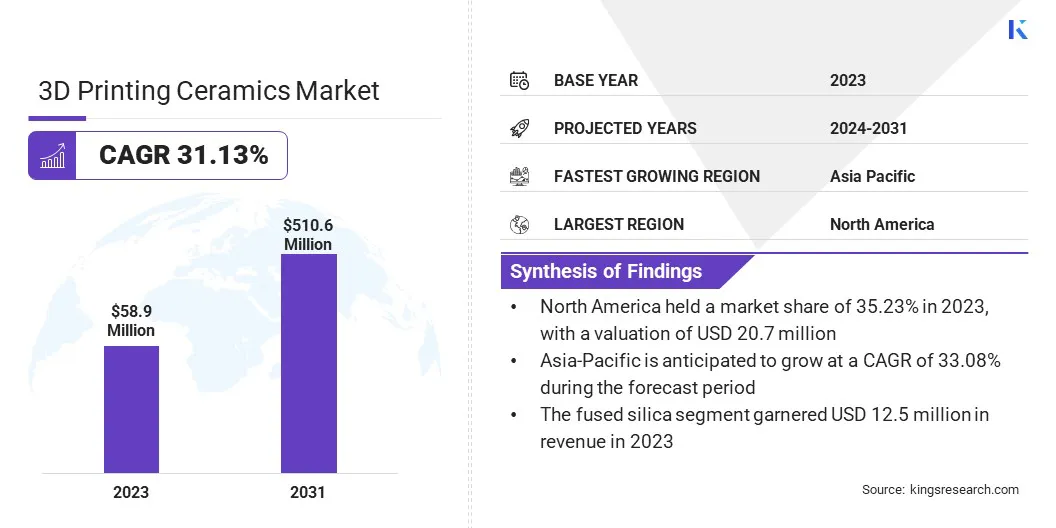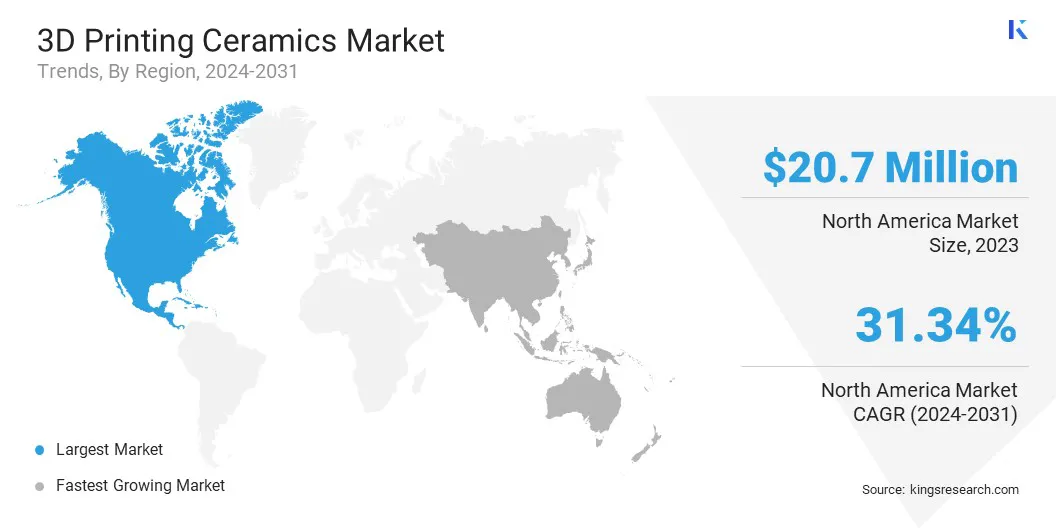3D Printing Ceramics Market Size
The global 3D Printing Ceramics Market size was valued at USD 58.9 million in 2023 and is projected to grow from USD 76.6 million in 2024 to USD 510.6 million by 2031, exhibiting a CAGR of 31.13% during the forecast period. The market is expanding rapidly due to the rising demand for complex and high-precision components in automotive, aerospace, and electronics applications.
The ability to produce lightweight and heat-resistant parts is driving innovation and adoption. Additionally, increasing collaborations between manufacturers and research institutions are for technological advancements is further enhancing market growth. In the scope of work, the report includes solutions offered by companies such as Lithoz, 3DCeram, Tethon3D, PRODWAYS, Steinbach AG, Desamanera S.r.l., Elementum, Emerging Objects, ExOne, 3D Systems, Inc., and others.
The 3D printing ceramics market is experiencing robust growth due to advancements in material science and printing technologies. High-performance ceramic composites like alumina and zirconia are witnessing a high adoption across industries, such as healthcare, aerospace, and electronics, due to their superior strength, durability, and thermal stability.
Customization and precision offered by 3D printing enable tailored solutions, particularly in medical and dental applications. The market is also benefiting from increased investments in research and development, leading to innovation and expanding capabilities.
- According to Press Information Bureau, in February 2022, the Indian government announced an ambitious plan to capture 5% of the global 3D printing market, aiming to add USD 2-3 billion to the GDP by 2025. This initiative includes developing 50 India-specific technologies across materials, machines, processes, and software, positioning India as a hub for 3D-printed design and manufacturing.
Such government support and strategic investments are accelerating technology propagation and adoption, fostering innovation, and enhancing the global competitiveness of the market.
3D printing ceramics involves using additive manufacturing techniques to create objects from ceramic materials. This process builds up layers of ceramic powder, which are selectively fused using a binding agent or a laser, to produce complex and precise geometries that traditional manufacturing methods cannot achieve.
Ceramics used in 3D printing include materials like alumina, zirconia, and silica, known for their excellent mechanical properties, thermal stability, and biocompatibility. 3D printing ceramics is increasingly utilized in industries such as healthcare, aerospace, and electronics, offering significant advantages in producing customized, durable, and high-performance components for specialized applications.

Analyst’s Review
Continuous research and development in 3D printing technologies are driving the 3D printing ceramics market growth by enabling the production of advanced ceramic components with enhanced properties. These innovations are expanding the applications of 3D printing ceramics across various high-demand industries, such as aerospace and energy.
- In September 2023, Penn State Professor Stephen Lynch and his team discovered a 3D printing procedure for creating high-temperature ceramic gas turbine components, showcasing the potential for improved performance and efficiency in extreme conditions.
Key players are leveraging these advancements by investing in R&D and collaborating with research institutions to develop high-performance ceramic components. These efforts are expected to enhance market growth by enabling more efficient, durable, and customized solutions, meeting the increasing demand from aerospace, healthcare, and energy segments over the coming years.
3D Printing Ceramics Market Growth Factors
The increasing adoption of 3D printing ceramics in healthcare and aerospace is significantly driving their market growth. In healthcare, this technology is being used to create customized implants and prosthetics, tailored to individual patient needs to improve treatment outcomes and patient comfort.
In addition, in aerospace, 3D printing ceramics is facilitating the production of lightweight and durable components with complex geometries, which are enhancing performance and fuel efficiency. The technology is producing high-performance materials that, thereby meeting (the link between fragments is missing. Please read the complete sentence and rephrase it for clarity) the stringent demands of these advanced industries and fueling market expansion.
A significant challenge hindering the growth of the market is the high cost of advanced ceramic materials and 3D printing equipment. These costs may limit adoption, particularly for smaller companies or startups with limited budgets. Additionally, the complexity of processing non-oxide ceramics and achieving desired material properties can pose technical difficulties, further restricting market expansion.
Key players in the 3D printing ceramics market are addressing these challenges by investing in research and development to reduce material costs and enhance processing techniques. Companies are working on developing more cost-effective ceramic powders and improving 3D printing technology to streamline production processes. Collaboration with research institutions and increased focus on innovation are helping to overcome technical difficulties and drive broader market adoption.
3D Printing Ceramics Market Trends
The trend favoring customization and personalization of medical implants and dental prosthetics is significantly propelling market growth. The advanced capabilities of 3D printing ceramics to produce tailored solutions that precisely meet individual patient needs are driving product adoption in the medical field. This technology offers superior compatibility with patient anatomy, reduces complications, and enhances functionality, leading to higher patient satisfaction.
The rising demand for personalized medical solutions is translating into greater investment and innovation in 3D printing ceramics, which is expected to drive this market over the forecast period. Innovations in ceramic materials, such as advanced alumina and zirconia composites, coupled with continuous advancements in 3D printing technologies, are significantly enhancing the capabilities of 3D printing ceramics.
- In June 2023, designed for large-scale ceramic 3D printing, WASP presented the Delta Wasp 40100 Clay Production 3D printer with a continuous feeding system to guarantee a consistent supply of material.
These technological improvements are yielding superior performance characteristics, including higher strength, increased durability, and improved thermal stability. These properties are critical for demanding applications across industries like healthcare, aerospace, and electronics.
For instance, alumina composites deliver excellent wear resistance and electrical insulation, while zirconia composites offer superior toughness and biocompatibility. These advancements are expected to drive the adoption of 3D printing ceramics and propel market growth.
Segmentation Analysis
The global market has been segmented on the basis of type, form, end user, and geography.
By Type
Based on type, the market has been categorized into glass, quartz, fused silica, and others. The fused silica segment led the 3D printing ceramics market in 2023, reaching a valuation of USD 12.5 million. This segment is experiencing significant growth due to its critical role in producing high-precision and high-performance components used in aerospace, electronics, and energy applications.
The increasing demand for advanced manufacturing techniques that require high-quality, durable materials is fueling the adoption of fused silica. Additionally, advancements in 3D printing technologies and continuous innovation in material formulations are further boosting the segment growth, as industries seek enhanced performance and reliability in their end products.
By Form
Based on form, the market has been categorized into liquid, filament, and powder. The powder segment captured the largest 3D printing ceramics market share of 68.76% in 2023. High-quality ceramic powders, such as alumina, zirconia, and silica, are in demand for their ability to produce precise and durable components to cater to various industries.
Advances in this segment are enhancing particle size control and flow characteristics, which improve print quality and performance. As industries like aerospace, healthcare, and electronics seek customized, high-performance parts, the demand for advanced ceramic powders continues to rise. This trend is driving significant investments and innovation within the powder segment, fueling the overall market growth.
By End User
Based on end user, the market has been categorized into aerospace & defense, healthcare, automotive, and others. The aerospace & defense segment is expected to account for the highest revenue of USD 157.2 million by 2031, mainly due to the increasing demand for advanced materials capable of withstanding extreme conditions.
3D printing ceramics, such as high-temperature-resistant and lightweight composites, are crucial for producing components like turbine blades, heat shields, and structural parts that require high performance and durability. Innovations in ceramic materials and printing technologies are enhancing their ability to create complex geometries and reduce manufacturing costs.
Aerospace and defense industries focus on improving efficiency and performance, which is fueling the adoption of 3D printing ceramics, driving significant growth in this segment.
3D Printing Ceramics Market Regional Analysis
Based on region, the global market has been classified into North America, Europe, Asia-Pacific, MEA, and Latin America.

North America 3D printing ceramics market share stood around 35.23% in 2023 in the global market, with a valuation of USD 20.7 million. The automotive and aerospace industries in the U.S. are notably expanding their use of 3D printed ceramics due to their exceptionally high strength, heat resistance, and dimensional stability.
These materials are utilized to produce lightweight, durable car parts and complex aircraft components. In the medical segment, 3D printing ceramics are used for customized implants and prostheses. Additionally, the electronics industry benefits from ceramics in high-performance circuit boards, while the construction industry leverages this technology for producing architectural models and prototypes. These use cases are expected to drive the market over the forecast period.
Asia-Pacific is anticipated to witness the fastest growth at a CAGR of 33.08% over the forecast period. In China, the use of ceramic inks for food container printing is a key application, creating attractive and durable designs. The beverage industry is also using ceramic inks to produce intricate and high-end labels on bottles, enhancing their visual appeal. This 3D printed decorative bottles are expected to see substantial sales over the next decade.
Additionally, increasing investments in advanced manufacturing technologies and the rising demand for customized and high-performance components in electronics, automotive, and healthcare industries are further propelling market expansion in the region.
Competitive Landscape
The global 3D printing ceramics market report provides valuable insights with an emphasis on the fragmented nature of the industry. Prominent players are focusing on several key business strategies, such as partnerships, mergers and acquisitions, product innovations, and joint ventures, to expand their product portfolio and increase their market shares across different regions.
Companies are implementing impactful strategic initiatives, such as expanding services, investing in research and development (R&D), establishing new service delivery centers, and optimizing their service delivery processes, which are likely to create new opportunities for market growth.
List of Key Companies in 3D Printing Ceramics Market
- Lithoz
- 3DCeram
- Tethon3D
- PRODWAYS
- Steinbach AG
- Desamanera S.r.l.
- Elementum
- Emerging Objects
- ExOne
- 3D Systems, Inc.
Key Industry Development
- December 2023 (Agreement): Lithoz GmbH and the U.S. Department of Energy’s Oak Ridge National Laboratory signed a Cooperative Research and Development Agreement to utilize Lithoz’s 3D printing technology for advancing the processing and additive manufacturing of non-oxide ceramics.
The global 3D printing ceramics market has been segmented as below:
By Type
- Glass
- Quartz
- Fused Silica
- Others
By Form
By End User
- Aerospace & Defense
- Healthcare
- Automotive
- Others
By Region
- North America
- Europe
- France
- U.K.
- Spain
- Germany
- Italy
- Russia
- Rest of Europe
- Asia-Pacific
- China
- Japan
- India
- South Korea
- Rest of Asia-Pacific
- Middle East & Africa
- GCC
- North Africa
- South Africa
- Rest of Middle East & Africa
- Latin America
- Brazil
- Argentina
- Rest of Latin America


